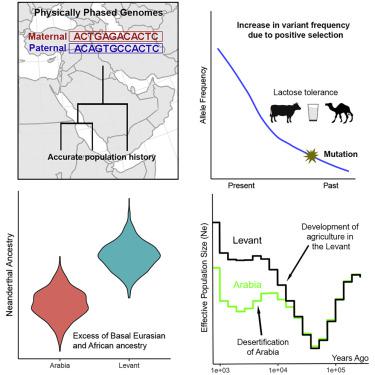Cell ( IF 64.5 ) Pub Date : 2021-08-04 , DOI: 10.1016/j.cell.2021.07.013 Mohamed A Almarri 1 , Marc Haber 2 , Reem A Lootah 3 , Pille Hallast 4 , Saeed Al Turki 5 , Hilary C Martin 6 , Yali Xue 6 , Chris Tyler-Smith 6

|
The Middle East region is important to understand human evolution and migrations but is underrepresented in genomic studies. Here, we generated 137 high-coverage physically phased genome sequences from eight Middle Eastern populations using linked-read sequencing. We found no genetic traces of early expansions out-of-Africa in present-day populations but found Arabians have elevated Basal Eurasian ancestry that dilutes their Neanderthal ancestry. Population sizes within the region started diverging 15–20 kya, when Levantines expanded while Arabians maintained smaller populations that derived ancestry from local hunter-gatherers. Arabians suffered a population bottleneck around the aridification of Arabia 6 kya, while Levantines had a distinct bottleneck overlapping the 4.2 kya aridification event. We found an association between movement and admixture of populations in the region and the spread of Semitic languages. Finally, we identify variants that show evidence of selection, including polygenic selection. Our results provide detailed insights into the genomic and selective histories of the Middle East.
中文翻译:

中东的基因组历史
中东地区对于了解人类进化和迁移很重要,但在基因组研究中代表性不足。在这里,我们使用链接读取测序从八个中东人群中生成了 137 个高覆盖率的物理定相基因组序列。我们在当今的人口中没有发现非洲早期扩张的遗传痕迹,但发现阿拉伯人的基础欧亚血统升高,这削弱了他们的尼安德特人血统。该地区的人口规模开始出现 15-20 kya 的差异,当时黎凡特人扩张,而阿拉伯人则保留了来自当地狩猎采集者血统的较小人口。阿拉伯人在阿拉伯 6 kya 的干旱化过程中遇到了人口瓶颈,而黎凡特人的人口瓶颈与 4.2 kya 干旱化事件重叠。我们发现该地区人口的流动和混合与闪族语言的传播之间存在关联。最后,我们确定了显示选择证据的变体,包括多基因选择。我们的结果提供了对中东基因组和选择性历史的详细见解。


























 京公网安备 11010802027423号
京公网安备 11010802027423号